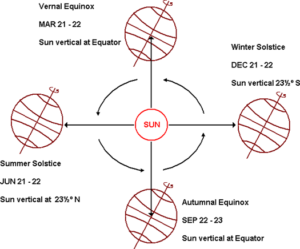Earth-Sun Relationship
General Division of Seasons
Generally, the division of the year into seasons varies with latitude. In middle latitudes, the year is divided into ‘autumn’, ‘winter’, ‘spring’, and ‘summer’. The terms ‘summer’ and ‘winter’ are not as significant in the tropics. Instead, division is usually made in terms of rainfall, such as the ‘rainy season’ and ‘dry season’, or in terms of wind direction as ‘south-west monsoon’ and ‘north-east monsoon’ as in India. In the continental subtropical regions, seasons are often defined in terms of temperature (hot or cold), rainfall (rainy and dry), or both. In polar regions, the transition from summer to winter and vice versa is so sudden that spring and autumn largely disappear.
Solar Radiation and Earth’s Surface
Solar radiation is one of the most important sources of energy driving environmental processes on Earth’s surface. The amount and intensity of solar radiation reaching the Earth is influenced by the geometric relationship between the Earth and the Sun. The variations in solar radiation reaching the Earth are affected by latitude, the Earth’s rotation, and its revolution around the Sun. Understanding the geometric relationship between the Earth and the Sun explains why we experience different seasons.
Earth Rotation and Revolution
Earth’s Rotation
Earth’s rotation refers to the spinning of the Earth on its axis, which passes through the north and south poles. The Earth rotates eastward at a uniform rate once every 24 hours, which is called a mean solar day.
Earth’s Revolution
The Earth’s orbit around the Sun is called revolution. The Earth’s orbit is elliptical with the Sun at one focus, causing the Earth’s distance from the Sun to vary annually. The average distance between the Earth and the Sun is about 150 million kilometers. On 3rd January, the Earth is closest to the Sun at about 147.5 million km, known as perihelion. On 4th July, it is farthest from the Sun at about 152.5 million km, known as aphelion. These variations influence slight changes in solar radiation, but the distance from the Sun is not the cause of different seasons. Instead, seasons result from the tilt of the Earth’s axis.

Tilt of the Earth’s Axis
The Plane of the Ecliptic and Earth’s Tilt
The plane of the ecliptic is the Earth’s orbital plane around the Sun. The Earth’s axis is tilted by 23½º from the perpendicular to the plane of the ecliptic. This tilt remains constant as the Earth revolves around the Sun, a phenomenon known as parallelism of axes. The tilt causes changes in the angle at which solar rays strike a point on Earth throughout the year, known as the “sun angle.” The most intense solar radiation occurs when the sun’s rays strike the Earth at the highest angle. As the sun angle decreases, light spreads over a larger area and decreases in intensity due to atmospheric thickness, reflection, and scattering.

Solstices
Summer Solstice
On June 21 or 22, the Earth’s axis is tilted towards the Sun, and the subsolar point (where the Sun is directly overhead at noon) is at 23½º north latitude. This marks the summer solstice, the first day of summer in the northern hemisphere. It is the longest day for places north of the Tropic of Cancer (23½º N latitude). Areas north of 66½º N experience 24 hours of daylight (polar day), while places south of 66½º S are in complete darkness (polar night).

Winter Solstice
The winter solstice occurs on December 21 or 22 when the North Pole is tilted away from the Sun, and the subsolar point is at 23½º S latitude (Tropic of Capricorn). Places poleward of 66½º S receive 24 hours of daylight, while those poleward of 66½º N are in darkness. This marks the first day of winter in the northern hemisphere.


Equinoxes
Spring and Autumn Equinoxes
Midway between the solstices, the Sun shines directly on the equator during the equinoxes, when the axis of rotation is tilted sideways relative to the Sun. The tangent rays strike the poles, making day and night equal worldwide. The autumnal equinox occurs around September 22 or 23, marking the start of autumn in the northern hemisphere. The spring equinox happens around March 21 or 22, indicating the start of spring. Equinoxes are transitional periods between the more extreme seasons of summer and winter.
The Seasons
Opposite Seasons in Hemispheres
During summer, the Earth is inclined toward the Sun, resulting in higher sun angles. In winter, the Earth is tilted away from the Sun, leading to lower sun angles. The tilt of the Earth’s axis causes the opposite seasons in the northern and southern hemispheres. Summer occurs when a hemisphere is tilted toward the Sun, and winter occurs when it is tilted away.
Annual March of Seasons
Sun’s Rays and Sun Angle Variation
Over the course of a year, the Sun’s rays are perpendicular to the surface (directly overhead) only between the Tropic of Cancer (23½º N) and the Tropic of Capricorn (23½º S). These places experience two periods when the Sun is directly overhead, with minimal variation in sun angles. However, regions poleward of the tropics experience greater variation in sun angles and, consequently, more variation in surface heating.


